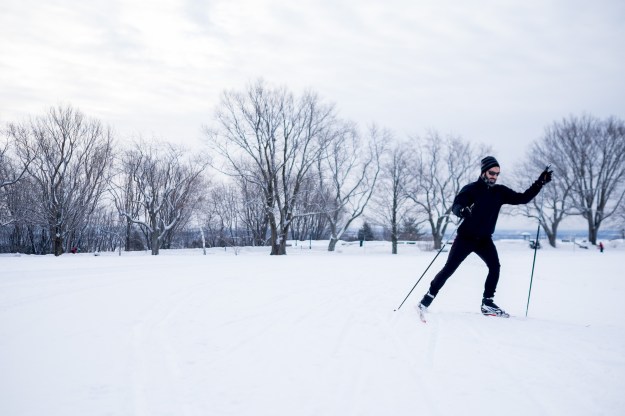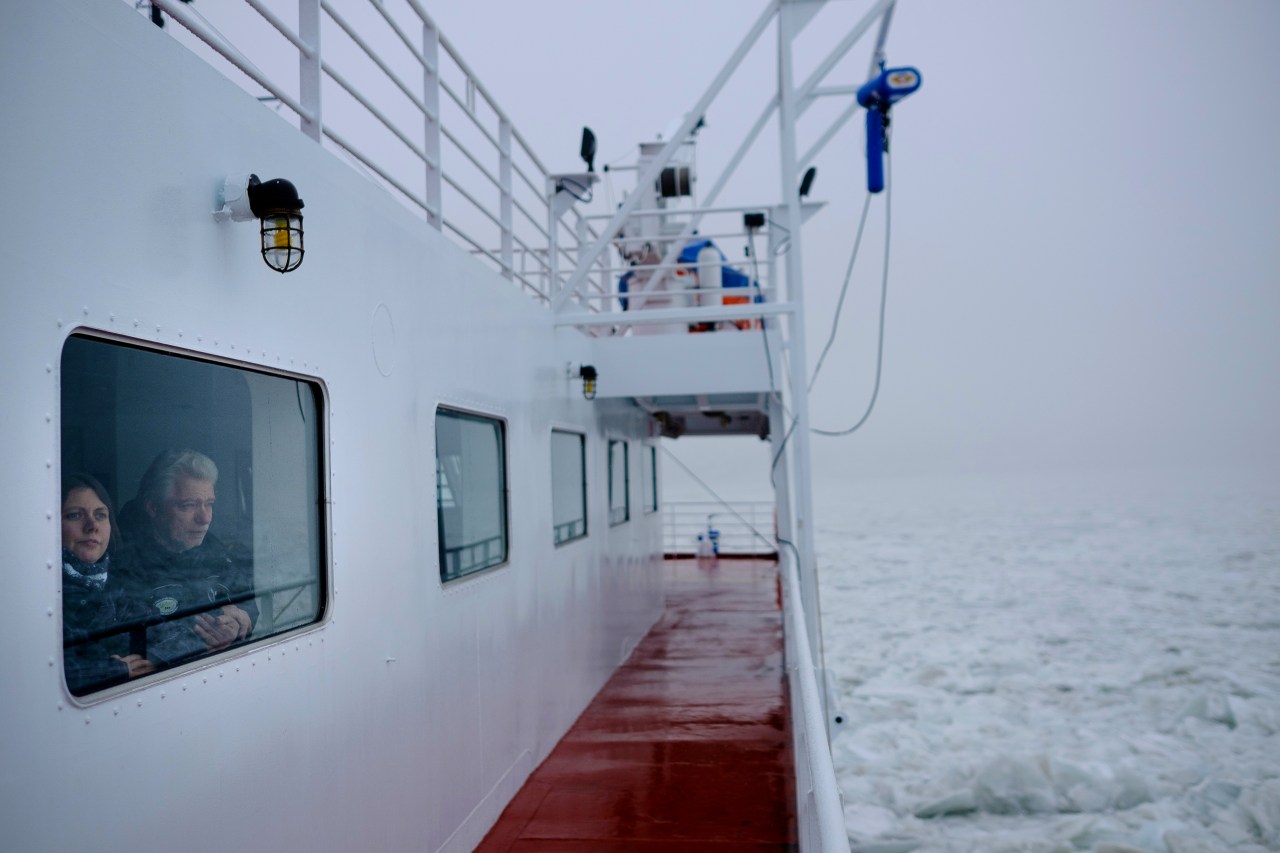The stone walls of Québec encircle a city that delights those with a love of architecture and food. The city is perhaps most enjoyable in the summer months, but is worth a visit even in the bone-chilling winter. And in the brief window between Christmas and the late January crowds of Carnival, when the wind whips snow into waist-high drifts, quiet blankets the city.
And still, in that silence, its streets are an energetic mix of tradition, tumultuous history, and experimentation. This is my perfect winter day through one of my favorite cities; starting with underrated bagels and ending with tobogganing.
Start the morning off at Bügel, the earlier the better. Enjoy the fresh bite of winter air as you walk to the green and white cafe on the corner of Rue Crémazie.
In the pitched battle over the best bagel—Montreal or New York—this small cafe doesn’t take sides. Bügel instead bakes their own, using local honey instead of sugar. And they have the credibility to back it up; they’re the first bagel makers in the city and have been a fixture of the Montcalm neighborhood for the last 30 years.
For breakfast, nine bagel choices including a daily special, are served toasted with eggs, Québécois cheese, fruit, and coffee. Watch the neighborhood wake up with the morning light streaming through the windows.

Make your way southeast down the tree-lined streets of Montcalm to the Plains of Abraham, where the pink tones of sunrise still hang over the frozen St. Lawrence river.
This old farmland, now the city’s largest park, was the end of France’s dreams in North America. In 1759, British soldiers snuck up the hills that now double as a cross country ski trail and launched a quick series of musket blasts. French aspirations—and the Seven Years War— began to unwind less than half an hour later.
As skiers push by, their heavy breath steaming in the air, it’s here that you’ll realize the Québécois way of surviving the winter is to embrace it.
More than eight miles of trails trace the outer edges and you’ll find a seasonal outdoor ice rink—complete with a warming hut—in the northern reaches of the park. The city rents skates and cross country skis, if you want to embrace winter like the locals.


Work up an appetite following the trails in a southern direction, keeping the icy St. Lawrence river on your right.
The park gives way to Dufferin Terrace, where the Chateau Frontenac stands on the left and the sweeping views of the Lower Town are to the right, providing an impressive view. Resist the temptation to stop for too long. You’ll be back later. Follow the streets down to the old port.
Arrive at Buffet L’Antiquaire—the Antique Dealer’s Buffet—on Rue Saint-Paul. After 40 years in the antique district, it attracts a diverse crowd, from chefs of high-end restaurants to laborers, all hungering for Québec classics. Locals perch on the maroon leather bar stools, continuing their running conversations with the staff.
Service is quick and specials are scrawled on an overhead chalkboard. It’s a diner—nothing fancy—but it serves up the hearty foods of the region’s culinary traditions. You can gorge on meat pies, baked beans, sugar pies, and Québécois hot chicken—green peas and slices of chicken topped with gravy.

The breakfast menu runs all day, so if you feel you’ve earned a second stab at it, L’Antiquaire is more than happy to oblige with neatly rolled crepes, potatoes, and eggs, accompanied by a bowl of maple syrup.
Coffee refills are free—the limits are unclear, but I reached five before voluntarily cutting myself off.
Make your way to the Maison de la Littérature on Rue Saint-Stanislas to marvel at the church space that’s recently been converted by a team of architects from Montreal into an ode to Québécois literature.
As the afternoon light streams in through the arches you can explore the linguistic traditions and history that the province is fighting to protect from a steady Anglophone creep. More than 7 million Canadians claim French as their mother tongue, and Québec politicians fought hard for decades to have it recognized as one of Canada’s official languages. Books about ethnic identity and sovereignty line the shelves alongside feminism, comics, and poetry. The public library works not just to preserve and celebrate homegrown talents, but to share the successes of Québécois rights outside the province by inviting speakers and artists from abroad to present and establish creative residencies in the library.
Free to the public, the gorgeous church arches blend the city’s classical architecture with its ambitious future.

Cafes are scattered throughout most busy streets—finding great coffee is no challenge here. A smaller number of cafes have embraced coffee beans bought, roasted, and ground from a single source.
Cantook, a short walk from the Maison de la Littérature, is warm and congenial, complete with chopped firewood in the front windows. The freshly roasted coffee here is some of the best in the city. Young people work scattered at the tables and an older generation, less interested in the glow of technology, chats with the baristas. Grab a croissant and watch the city stroll by.
Double back along Rue Saint-Jean towards the Old Town. Walking the steep cobblestones on a late winter afternoon, the lights of shops glowing against the snow, makes you want to stop and stare—there’s nothing else quite like this on the continent.
You may feel thrust into a Philip K. Dick novel—what if France had won North America?


Wandering the maze of shops, with golden threads of lights overhead, it’s easy to forget the cascading events of history that brought about the city—and how long ago it happened.
French captain Jacques Cartier arrived in 1534 to the Iroquois village of Stadacona, close to present-day Québec. Its residents kept the Europeans alive—helping them source vitamin-rich food like a blend of pine needles and white cedar bark in the winter to stave off scurvy.
It was from this first settlement that the modern iteration of Canada got its name. When Cartier returned to France, he excitedly told the French his hosts called their village kanata—their word for village—and it would eventually be known as Canada.

Down on the water, the commuter ferry from Québec to Lévis makes for a great trip to catch the sunset over the old city. Watching the glow of the city cutting through winter mist—accented by the sound of metal against ice—is among the best ways to spend $5 (Canadian). The ships leave every half an hour, and the trip across is less than 15 minutes.
Return to the Old Town, admiring how effectively rich history and culture can be bottled, packaged and wrapped for tourists.
To prove that the city isn’t just an open air museum to the past, head north from the water to dinner at Chez Boulay on Rue Saint-Jean.
Rich French and Québécois culinary traditions mean that many establishments, especially those within the walls of the Old Town, are content to keep producing the same dishes. But a small group of chefs are treating their kitchens and menus almost as testing labs. Cuisine Boréale weds protein-rich New Nordic-style dishes with plants grown in the area. Most of Québec is vast tracts of boreal (coniferous) forest reaching up to the Arctic.
Led by Arnaud Marchand, the team at Chez Boulay adheres to a strict set of standards—no ingredients can be served that can’t be picked, harvested or hunted in the region. That means no lemon juice, no olive oil. Instead, they consult with experts on local flora to help identify similar flavors in the forest using edibles like fir tips, cranberries, and birch syrup. “Most people from here don’t realize how much we can use,” says chef Erick Demers, Marchand’s right hand in the kitchen. “They drive by cattails, not realizing they can taste just like palm hearts.”


While the food is inspired by French cooking, it is also grounded in the history of the area—of the early farmers and settlers who learned from indigenous inhabitants how to survive with resources from the surrounding forests. “The portions are most definitely Québécois,” says Demers.
A hefty dish of braised pork osso bucco, with meat that drops from the bone, comes with potatoes from the nearby Île d’Orleans, garlic flowers, and root vegetables stored especially for the winter.
The menu changes daily to reflect available ingredients, so each visit is a surprise.
A wooden toboggan track is the source of whoops and screams cutting into the night. Placed on Dufferin Terrace, this quaint but fun attraction makes it is worth returning back to this spot. On Friday and Saturdays, slide all the way until 9 p.m., for only $3. “I’d say you hit 45 miles an hour,” says Gary Knox, the ear flaps of his trapper hat batting as he readies the wooden toboggans. Working as the operator for the last three years, his tenure on the slide is a small dent in its 133 years of operation.
Much of the city feels that way—the memory of Québec stretches back generations as modern life goes on in the shadow of architectural marvels.
At the top of the icy run, you’re consumed by the knowledge that its ramparts, winding streets, and spires that pierce the clouds, are old, and yet will outlast you. But don’t think about that; for now, just enjoy the ride.
